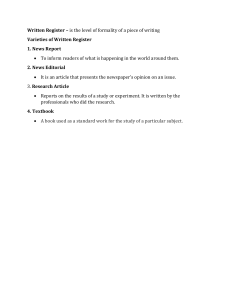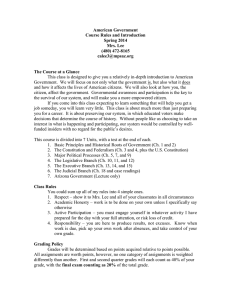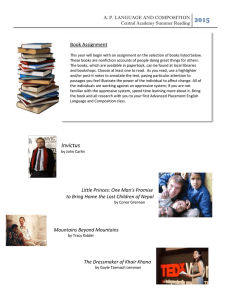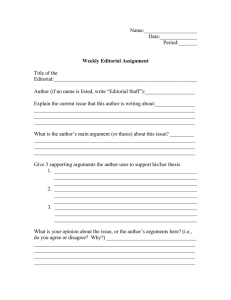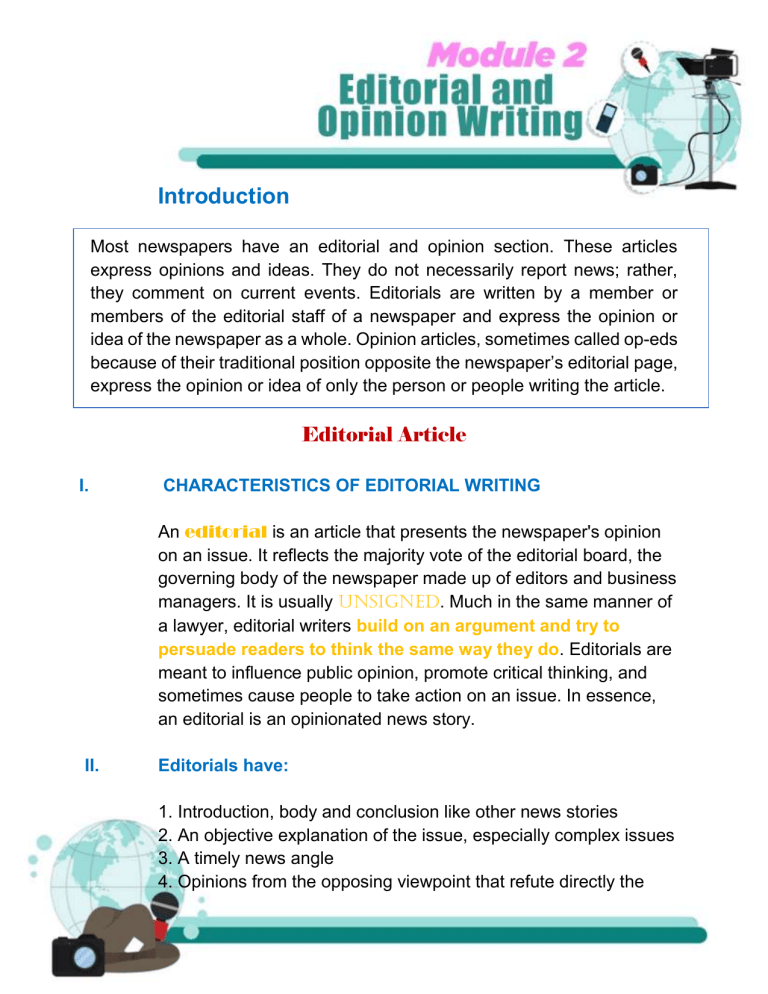
Introduction Most newspapers have an editorial and opinion section. These articles express opinions and ideas. They do not necessarily report news; rather, they comment on current events. Editorials are written by a member or members of the editorial staff of a newspaper and express the opinion or idea of the newspaper as a whole. Opinion articles, sometimes called op-eds because of their traditional position opposite the newspaper’s editorial page, express the opinion or idea of only the person or people writing the article. Editorial Article I. CHARACTERISTICS OF EDITORIAL WRITING An editorial is an article that presents the newspaper's opinion on an issue. It reflects the majority vote of the editorial board, the governing body of the newspaper made up of editors and business managers. It is usually unsigned. Much in the same manner of a lawyer, editorial writers build on an argument and try to persuade readers to think the same way they do. Editorials are meant to influence public opinion, promote critical thinking, and sometimes cause people to take action on an issue. In essence, an editorial is an opinionated news story. II. Editorials have: 1. Introduction, body and conclusion like other news stories 2. An objective explanation of the issue, especially complex issues 3. A timely news angle 4. Opinions from the opposing viewpoint that refute directly the same issues the writer addresses 5. The opinions of the writer delivered in a professional manner. Good editorials engage issues, not personalities and refrain from name-calling or other petty tactics of persuasion. 6. Alternative solutions to the problem or issue being criticized. Anyone can gripe about a problem, but a good editorial should take a pro-active approach to making the situation better by using constructive criticism and giving solutions. 7. A solid and concise conclusion that powerfully summarizes the writer's opinion. Give it some punch. III. Four Types of Editorials Will: 1. Explain or interpret: Editors often use these editorials to explain the way the newspaper covered a sensitive or controversial subject. School newspapers may explain new school rules or a particular student-body effort like a food drive. 2. Criticize: These editorials constructively criticize actions, decisions or situations while providing solutions to the problem identified. Immediate purpose is to get readers to see the problem, not the solution. 3. Persuade: Editorials of persuasion aim to immediately see the solution, not the problem. From the first paragraph, readers will be encouraged to take a specific, positive action. Political endorsements are good examples of editorials of persuasion. 4. Praise: These editorials commend people and organizations for something done well. They are not as common as the other three. IV. Writing an Editorial 1. Pick a significant topic that has a current news angle and would interest readers. 2. Collect information and facts; include objective reporting; do research. 3. State your opinion briefly in the fashion of a thesis statement 4. Explain the issue objectively as a reporter would and tell why this situation is important. 5. Give opposing viewpoint first with its quotations and facts 6. Refute (reject) the other side and develop your case using facts, details, figures, quotations. Pick apart the other side's logic. 7. Concede a point of the opposition — they must have some good points you can acknowledge that would make you look rational. 8. Repeat key phrases to reinforce an idea into the reader's minds. 9. Give a realistic solution(s) to the problem that goes beyond common knowledge. Encourage critical thinking and pro-active reaction. 10. Wrap it up in a concluding punch that restates your opening remark (thesis statement). 11. Keep it to 500 words; make every work count; never use "I" V. A Sample Structure A. Lead with an Objective Explanation of the Issue/Controversy. Include the five W's and the H. (Members of Congress, in effort to reduce the budget, are looking to cut funding from public television. Hearings were held …) Pull in facts and quotations from the sources which are relevant. Additional research may be necessary. B. Present Your Opposition First. As the writer you disagree with these viewpoints. Identify the people (specifically who oppose you. (Republicans feel that these cuts are necessary; other cable stations can pick them; only the rich watch public television.) Use facts and quotations to state objectively their opinions. Give a strong position of the opposition. You gain nothing in refuting a weak position. C. Directly Refute The Opposition's Beliefs. You can begin your article with transition. (Republicans believe public televison is a "sandbox for the rich." However, statistics show most people who watch public television make less than $40,000 per year.) Pull in other facts and quotations from people who support your position. Concede a valid point of the opposition which will make you appear rational, one who has considered all the options (fiscal times are tough, and we can cut some of the funding for the arts; however, …). D. Give Other, Original Reasons/Analogies In defense of your position, give reasons from strong to strongest order. (Taking money away from public television is robbing children of their education …) Use a literary or cultural allusion that lends to your credibility and perceived intelligence (We should render unto Caesar that which belongs to him …) E. Conclude with Some Punch. Give solutions to the problem or challenge the reader to be informed. (Congress should look to where real wastes exist — perhaps in defense and entitlements — to find ways to save money. Digging into public television's pocket hurts us all.) A quotation can be effective, especially if from a respected source A rhetorical question can be an effective concluder as well (If the government doesn't defend the interests of children, who will?) Opinion Article I. What is an opinion article? An opinion article, sometimes referred to as an op-ed article, is a commentary written by someone who is independent of the newspaper. These articles are published alongside the editorials, columnists and letters on the two Views pages of the IHT. These are the only pages on which the IHT presents opinions, whether those attributed to the paper, to columnists or to contributors. The Views pages are entirely independent of the news pages. The editors and reporters of the news department are not allowed to inject opinions into their work, nor to write for the Views pages. The editor of the editorial pages answers directly and solely to the Publisher. II. What is the difference between an opinion article, an editorial, a column and a letter? Each part of the Views pages has its own function. The editorials in the IHT represent the opinion of the newspaper and its parent, The New York Times. They are produced by the editorial board of The Times and the IHT after discussions in which editorial-page editors of the IHT participate by telephone. We also use editorials from the Boston Globe, which is part of the New York Times family of newspapers. Letters to the Editor are the response of readers to articles or editorials in the paper. The columnists are writers who appear regularly under an arrangement with the paper, whose views do not necessarily represent those of the paper. The opinion articles are contributed by people from outside the paper and represent their own views. III. Some tips on writing an opinion article: 1. Aim for about 750 words, but don't stretch the thought. If it's perfect at 400, great; if it absolutely demands 1,000, we'll try to accommodate it. 2. Open with a clear sense of what you're writing about and why the reader should care about it, then continue with a cogent argument. 3. Lead to a strong conclusion. Too many articles give a great description of the problem, but then peter out into a feeble conclusion that "it's high time" somebody does something. Give us a forward-looking and original solution. 4. That said, there's no fixed formula. We like stylistic innovation. 5. Don't wait too long. News quickly goes stale. 6. Carefully chosen, concrete examples and anecdotes bring an issue alive for the reader. Don't try to pack too many thoughts into your essay. One point argued thoroughly is usually enough. 7. Avoid formal language, righteous sentiment and bureaucratic or think-tank jargon. You're writing for the general reader, who may not know the difference between Unmic, Kfor and Doha. 8. Be passionate, by all means, but spare us your bar-room raves. 9. Avoid clichés like the plague. Opinion Article Sample 1 Shortages, a long list by Jullie Y. Daza At 11:32 p.m. precisely on Sept. 1, I heard my first carol of the year, “White Christmas.” Twelve hours earlier, Pedro, a father of four, put up his Christmas tree and pulled out box after box of ornaments. Later in the day, TV5 launched the network’s Christmas look. Nope, there’s no shortage of hopes for a “normal” Christmas celebration complete with twinkly decorations on the tree, Nativity creches on the most important table in the house, fairy lights to frame windows. We’re just biding our time — 107 days of the SOND months, September, October, November, December – before we hit Christmas Day and its signature abundance of toys, gifts, special menus, and loving greetings. And yet, and yet, in a country so blessed with fertile soil, mountains, seas, and talented people, why is there a perennial shortage of goods and services the whole year round? On a blue Monday this list of shortages suggested itself with each letter of the alphabet. Ayuda and not for biyuda only; Bonuses and other benefits for the low-salaried, such as trash collectors; Cemeteries, crematoriums; Drug lords still to be put away, eternally; Energy to run our plants, electricity for faraway hamlets; Food for the hungry; Garlic, galunggong, ginger; Hospitals and an upgrade of the healthcare system; Irrigation systems; Jobs for the unemployable; Kindness all around; Labs to test for more COVID suspects; Money (more for the hardworking middle class who pay taxes); Nurses and contact tracers; Opportunities for new graduates, oxygen tanks for patients; Plumbers – where to find and hire them?; Quality, not merely qualified, candidates for election; Rest and relaxation, with pay, for exhausted frontliners; Sugar;Tenement housing for the masses; Upo, patola, sitaw, patani; Vaccines, more and more, before Christmas comes! Water, water, also during the rainy season; Xemplary characters in public life; Younger generations of farmers, or else who’ll plant our food in the future? Zeal, of the type displayed by Yorme and Mark Villar. Does this look like the longest wish list in the world? Well, these are abnormal times, Santa! Editorial Article Sample 1 Reset on MECQ: Let’s get COVID containment priorities right Published September 9, 2021, 12:02 AM by Manila Bulletin In a move that caught many by surprise, the government has extended the modified enhanced community quarantine (MECQ) in Metro Manila by another week. The manner in which the announcement was made was as concerning as the message itself. The presidential spokesperson finally announced the deferment after a few hours of putting reporters on hold, as the guidelines were still unavailable. In a pandemic, people expect — and deserve — to get clear-cut directions from their leaders at all levels. Eighteen months after the first ECQ was enforced nationwide, is the country better prepared and more effective in containing the spread of the pandemic? The rapid community transmission of the Delta variant prompted the imposition of ECQ, the harshest quarantine restriction, starting in mid-August. It came about as the government began to ramp up nationwide vaccination efforts. But government data show that despite a high number of apprehensions made by the police, mobility restriction was not as high. Social gatherings have been tagged as a source of higher infection levels. The high transmissibility rate of the Delta variant has caused breakthrough infections among those that have been vaccinated and a perceptible increase in pediatric COVID cases. Granular lockdown with four alert levels was announced as the new tack for attacking COVID-19’s continuing affliction. But on the eve of its expected start, the government could not issue the specific guidelines on how it would be implemented, citing the need “for additional inputs from the local government units (LGUs).” Vaccination pace picked up during the last two weeks. As of September 4, 18.7 million of 17.3 percent have been given at least one dose; those fully vaccinated have reached 15.1 million or 14 percent. According to Vaccination Czar Carlito Galvez, Jr., the country’s daily vaccination rate was at 426,653 as of 1 August, with 1,743 active vaccination sites operating across 17 regions nationwide. The government targets to vaccinate 70 percent or 77,139,058 Filipinos out of the country’s 110,198,654 total population in order to achieve population protection by yearend. For this target to be attained in the remaining 114 days of the year, the daily vaccination rate would have to be ramped up to 544,000. At the current rate of vaccination, it would take until the end of January 2022 for the goal of community protection to be attained, assuming of course that there would be adequate vaccine supplies. Vaccination is still the most effective antidote to the pandemic. This is why fake news and disinformation should be dispelled in order to overcome vaccine hesitancy. Whatever form of quarantine or lockdown is eventually implemented, the basics remain the same. Targeted testing must be done intensively in communities and workplaces to assure early detection. Contact tracing, despite the continuing absence of a universally accepted mobile app, would have to be done efficiently. The health care system’s capacity must be strengthened; the 2022 national budget is the best place to start. Even as the country gears for the start of a political campaign early next year, our leaders must continually seek effective solutions for tackling the pandemic. Editorial Article Sample 2 Big task for the Little President by Anna Mae Lamentillo In political circles, the Executive Secretary is often referred to as the “Little President,” but the task is no little as could be attested by the ES Salvador Medialdea himself, who was already thinking of retirement when he was given the daunting task by President Rodrigo Duterte. Secretary Medialdea dedicated much of his professional life to private law practice, first at ACCRA and PECABAR law offices before establishing his own law firm. He had short stints in the government—as administrator of the Livelihood Corporation (LIVECOR) in 1998, and as presidential assistant for Political Affairs in 2000 —but he preferred private practice. However, when he was handpicked by the President to be executive secretary, he could not say no to the man who he holds in high regard and he considers as one of his mentors. Secretary Medialdea looked up to his father, Leo D. Medialdea, who was also a lawyer and later on an Associate Justice of the Supreme Court. Thus, when he was appointed in government, his father’s example served as his guiding principles in public service. He recalls his father’s words that he took to heart: “So long as you can soundly sleep with what you are doing, you are in the right direction.” As ES, Secretary Medialdea assists the President in managing the vast government bureaucracy so that it would be aligned with the President’s vision of a better Philippines for Filipinos. He crafts critical issuances to implement the President’s programs, such as the “Build, Build, Build,” a program he greatly believes in as it will enable the efficient flow of goods and movement of people, which are needed for progress. In fact, if the Little President was President, he would also prioritize infrastructure, stressing that it makes the most impact in the lives of people. He says, “The presence or absence of good infrastructure shape a country’s destiny. Good infrastructure nurtures progress and growth.” He shares that the work of an ES is not easy, but the President’s work energy and commitment to the people is contagious that it inspires the Secretary to always deliver his best. His dream is that “the next generations of Filipinos, when they look back at this period of our history, will find us faithful stewards of the offices entrusted to us during this difficult time.” While his work can be daunting, the Secretary still finds time to do things that he loves. He enjoys riding motorbikes, playing golf, and playing musical instruments such as the piano and guitar. He also loves to travel domestically to appreciate the beauty of the Philippines. But when asked about his fondest memory of President Duterte, Secretary Medialdea goes decades back to the time when, while waiting for his client’s case to be called at a trial court in Davao City, he randomly sat on a chair just outside the courtroom. He saw a man walking towards him and a girl shouted telling him he was sitting on the fiscal’s chair. The man said to him, “No problem, attorney. You can use my seat.” That man he met was then Fiscal Rodrigo Duterte, and that brief encounter would later change his life. Answer Sheet Name: Year/Block: Date: Test I. Similarities and Differences. Directions: Using a Venn Diagram, write at least 5 or more words/group of words for each topic. Write a 3-5 sentence explanation below to support your answer (20 pts) Editorial Explanation: Opinion Test II. Editorial Writing Directions: Write your own editorial article. (30 pts) Test III. Opinion Writing\ Directions: Write your own Opinion article. (30 pts)
